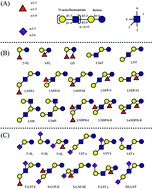Chromatographic methods for the analysis of oligosaccharides in human milk
Abstract
Human milk oligosaccharides (HMOs) are important components in human milk because of their high concentrations and benefits to infant growth. To better understand the relationship between oligosaccharide structures and biofunctions, efficient qualitative and quantitative methods are essential prerequisites. However, HMOs are highly complex and difficult to analyze because of their high polarity, lack of chromophores, and the presence of multiple isomeric structures. Although advanced mass spectrometry can provide much detailed structural information, chromatography is still important to reduce the complexity of HMOs in mixtures. The objective of this review is to describe and discuss the recent advances in the analysis of HMOs with the applications of different chromatographic methods, including gel permeation, high performance anion-exchange, porous graphitized carbon, hydrophilic interaction, reversed-phase high performance liquid chromatography, and capillary electrophoresis. These methods have been used to characterize the structures of HMOs, profile oligosaccharides obtained from the milk of different mothers, and measure the concentration changes in the course of lactations. For each method, we focus on the separation principles, commonly used separation conditions, typical applications, and the ability to resolve the isomers.



 Please wait while we load your content...
Please wait while we load your content...